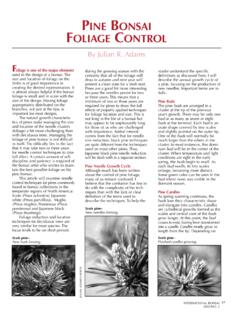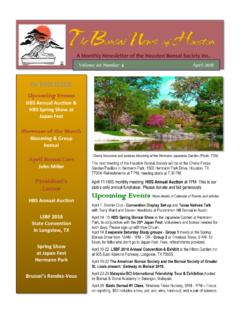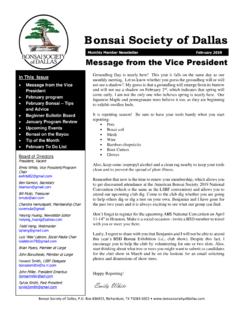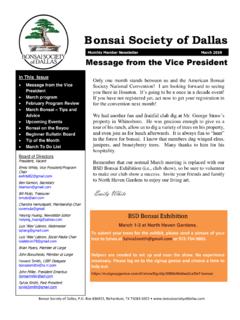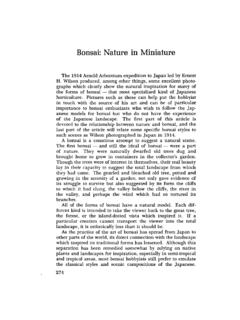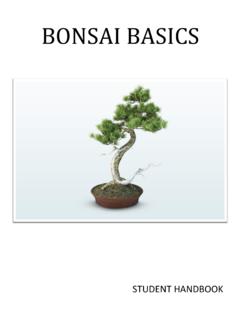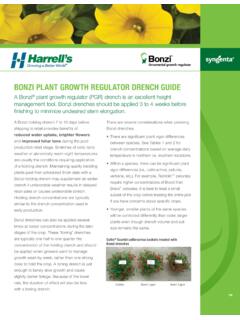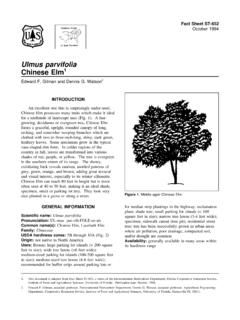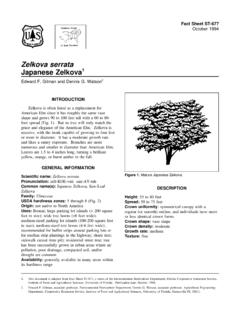Transcription of CHINESE ELM BONSAI - nebonsai.com
1 Ulmus parvifoliaThis is one of the best trees for starting out in Elms are strong, adaptable, and forgiving (upto a point!) Please don t confuse these trees withZelkova, which are more winter-hardy, and are adifferent species. CHINESE Elms have small, serratedleaves. They can develop twiggy branching another plusfor BONSAI . They are neither strictly indoor nor outdoor,but they do like to be outside for the ELM to the art and culture of BONSAI . Practicingbonsai can help us develop a deeper appreciation for thenatural world and for our fellow human beings. Bonsairequire patience, diligence, responsibility, creativity,and awareness, among other things. It is not always easy,yet BONSAI can enrich our lives with beauty and inspir-ation. If you pay attention to your BONSAI and take goodcare of it, you will enjoy it for many years. It s up to you!We can help you if you have england BONSAI gardens 508 883 2842 RNo single watering schedule can be applied to BONSAI .
2 BONSAI candry out quickly because they are planted in coarse soil and in shallowcontainers. In some cases, you may need to water every day, however,the frequency of watering depends on the type of tree, size of pot,type of soil, climate conditions, and more. The best way to tell if thebonsai needs water is to feel the soil. Stick your finger a half inch orso into the soil. Overall, if you do not feel much moisture in the tophalf inch of the soil, then it s time to must soak it well. Take the BONSAI to the sink, and either let it sitin the water for a few minutes (until it has soaked up enough fromthe drainage holes in the bottom), or shower from above, letting thewater drain through several times. Never let the soil dry out completely,but don t keep it soaking wet all the time. Base your watering on howthe soil feels. If you are not sure if it is wet or dry, take the BONSAI tothe sink and soak it well. Feel it an hour later, two hours later, fourhours later, etc.
3 This can help you understand how the soil it every day. If you can feel moisture, then you may not needto water. However, if your BONSAI is in a very small pot and/or it is ahot or windy day, or if the BONSAI is pot-bound, then you may needto water. Better safe than sorry. Feel the soil in several areas. If onepart is dry, then you need to water that let the BONSAI get too dry!LIGHTC hinese Elms can take full sun. Please be sure that the leaves areaccustomed to sun before you put the tree in strong sun. If the treehas been indoors, you need to expose it to sun slowly so that theleaves do not burn. Once they are acclimated, CHINESE Elms thrive infull sun and a lot of sun also helps to keep the leaves your BONSAI starts to push out fresh, light-green growth, it istime to start feeding. Apply mild organic fertilizer in the form ofpellets or liquid, usually with equal parts nitrogen, phosphorous andpotassium (NPK) during the growing season, and less nitrogen inthe fall.
4 Apply the pellets about once a month, and the liquid aboutevery two weeks. Once the growth of the tree starts to slow down, inmid to late summer, you can cut the fertilizer back to once a monthfor the liquid. When the BONSAI is in winter dormancy, there is noneed to feed it. Remember, never fertilize a weak air circulation is essential for the health of your BONSAI . Alwayskeep your CHINESE Elm in a well-ventilated place, such as an openwindow when inside, or use a small fan to increase air england BONSAI gardens 508 883 2842 AND DISEASESJust as children can catch a cold, your BONSAI are susceptible to thecommon houseplant pests and diseases. The best defense is to keepyour tree clean and healthy. Always observe the BONSAI closely. ChineseElms are prone to a fungal disease called black spot which appears asdark spots on the leaves. This must be treated. Spray with a fungicide(always follow directions) and remove any leaves which are more thanhalf damaged.
5 Keep the BONSAI in excellent air circulation and sun,and do not mist. You may need to treat it more than once. If younotice any abnormal leaf drop, stickiness to the foliage, or visibleinsects, you need to treat the problem. Start by showering the treedown with lukewarm water to thoroughly wash away any spray with a mild insecticidal soap or rotenone pyrethrin spray(always follow directions when using any insecticides). One spray isusually not enough. You may need to repeat the treatment once aweek for two or three weeks. Insects may be knocked back, but theycan reappear in a few weeks or months. Keep a watchful eye and bediligent about treating them. It is always best to consult with aprofessional as soon as you think you might have a your BONSAI grows, it will naturally shed some leaves. Always removedead leaves from the tree and from the top soil, and gently showerdown the foliage once a week.
6 This will help discourage pests Elm trees are very flexible about their environment. If adaptedproperly, they can be grown indoors year-round. If hardened off tothe cold gradually, they can drop their leaves in the fall and beconsidered deciduous trees, so you have a few options. However, it isimportant to find out how your Elm has been growing recently. SomeElms come from southern China, and have never experienced coldconditions. It would be dangerous to keep these Elms too cold thefirst year or two. Other Elms have gone to freezing and dropped theirleaves for many years; as a result, these Elms may not be too happyindoors for the first year or two. If you can not determine where yourElm has been, then keep it outside for the summer and bring it insidefor the winter. You can bring it in when the temperatures are around50 F. If kept indoors for the winter, a cooler location is preferable(50 F 65 F). CHINESE Elms may drop some leaves in the winter dueto the natural decrease in light.
7 This is england BONSAI gardens 508 883 2842 AND SHAPINGC hinese Elms are very fast-growing, so you can develop good branchramification in a relatively short time. It is important to keep upwith trimming when the Elm is growing quickly. Let two or threenew sets of leaves grow out, and cut back to one or two. Do not letthe branch grow too long (unless you are trying to thicken it). Howoften you trim will depend on how fast your tree grows. It s like ahaircut: you trim the foliage when it starts to look out-of-shape. Thekey is to never cut so much as to weaken the tree, but to cut enoughto keep it well-shaped. Sucker growth, which appears at the base ofthe trunk and in the elbows of the tree, can be removed, unless youwant to cultivate a branch or trunk in that area. Major pruning isusually done when the BONSAI is at its strongest, in early spring toearly safest time to repot your CHINESE Elm is when you see a lot ofbuds just starting to swell.
8 The time will vary from tree to tree, andfrom year to year. Even if your Elm has not dropped all its leaves, thisis the best way to tell when it is ready to transplant. Frequency ofrepotting depends on the size and age of the tree, the condition ofthe roots, and other factors. A younger tree may need transplantingevery year. Older, trees or those in larger pots, may need repottingevery two to four years. Repotting is an important procedure whichusually involves root pruning, and must be done properly. We canhelp you with this. You can also take a workshop or consult a reliablebook, BONSAI hobbyist, or local BONSAI AND STYLINGThe very best, most beautiful BONSAI are those which look natural. Ifyou observe aged trees in their native environment, you can feel theircharacter and strength. This is the ideal that we strive for in Elms can be trained in every BONSAI style, except maybe,formal upright. Because they are fast growing you can train a youngerspecimen to have a twisty trunk, or as a cascade or semi-cascade, in arelatively short amount of time.
9 Broom style is also a good option. 2004 New England BONSAI Gardens May not be reproduced in any form without permissionGardensNew England BONSAI Gardens is one of the finest,most beautiful BONSAI nurseries in America, witha world-class BONSAI collection, thousands of bonsaiand pre- BONSAI , pots, tools, books and want you to succeed with BONSAI . We offerworkshops, private tutorials, and to help you. Visit us at the nurseryanytime we are open year-round, seven days a week,from 9 am to 5 pm. You can also visit us online , where you can shop at ouronline store, access our catalog and newsletter, learnabout special events, and South Main Street, Bellingham MA 02019-1846 phone: 508 883 2842
